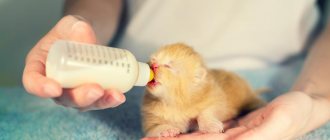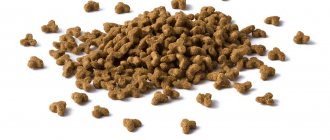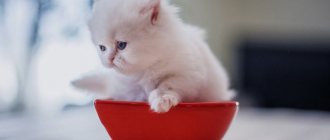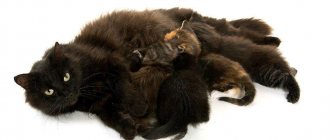History of the breed
Representatives of the new breed appeared as a result of breeding work with Siamese cats. Europeans and Americans liked the Thai cat so much that it surpassed its ancestors, the Siamese cats, in popularity.
The first mentions of cats of this breed date back to the 14th century. Bangkok manuscripts contain descriptions of exotic cats. As a result of breeding work, the type of Siamese cats has changed and become more refined. Representatives of the Thai breed first came to England in 1884. In 1920, the first animal came from Europe to the New World.
The breed received official approval in 1990 in Germany. The Thai breed is recognized as a closed breed, and mating of cats with representatives of other varieties is prohibited. Mating with other cats is carried out with the permission of the club in which the animal is registered.
There is a certain procedure for confirming the breed. A cat that has passed the examination of experts is issued a certificate of conformity and only after that can it be called Thai. Pets recognized as a pure breed take part in exhibitions and breeding.
Fans of the old type are engaged in breeding exclusively Siamese cats. These are the so-called apple-headed animals with powerful paws, a strong body, and a flatter chest. Siamese have become a rarer breed and are found much less frequently than their Thai relatives.
A peculiar coat color is incomplete albinism, when the coloring pigment is not completely present.
Prohibited Products
It is important to exclude prohibited foods from the Siamese kitten’s diet:
- Products containing sugar or its substitutes, xylitol (chewing gum, some sweets), flour or yeast, caffeine, cocoa, any stimulants (sweets, tea, coffee, chocolate), marinades, salt, spices.
- Bones, pure fat, skin, especially poultry.
- Palm oil.
- Grapes, raisins.
- Juicy and sweet fruits.
- Soy.
- Mushrooms.
- Corn and semolina.
- Raw freshwater fish.
- Dry, salted fish.
- Smoked products, including sausages, balyki, fish.
- Expired products.
- Leftovers from the table.
Controversial foods in the diet of a Siamese kitten are:
- Fresh pork is a source of helminths and false rabies.
- Raw ocean fish are a source of helminths.
- Whole milk – risk of individual intolerance.
- Chicken eggs are an allergen.
- Factory-bred chicken – risk of allergies and individual intolerances.
- Raw and boiled chicken liver in large quantities.
- Cereals.
The Siamese kitten's diet must include grains, otherwise, during the active growth stage, a depressed state and low activity will be observed. It is better to include rice and buckwheat in your pet's diet. If the kitten is severely stunted, wheat cereal can be introduced into the diet (on a temporary basis).
Healthy but allergenic foods should be introduced into your pet’s diet gradually, in small quantities. If after the first intake of the controversial product an allergic reaction does not occur within 3-4 days, it is fixed in the diet. Products that can become a source of helminth eggs and larvae should be boiled or frozen for 4–5 days.
Description
Thai cats have the color of the classic Siamese, but the body shape is more refined. The head is wedge-shaped, slightly elongated, the cheeks are plump, the transition from the nose to the forehead is clearly visible. The eyes are blue, slanted, almond shaped. Cross-eyed individuals are often found among cats; the breed allows this.
The ears are high and in some cases may have tufts. The neck is short or medium in size, strong and muscular. She cannot be called elegant and graceful. The limbs are medium-sized, round, strong with powerful pads.
Thai cats live 10–14 years and are a short-haired cat. The coat is without undercoat and lies tightly to the body.
Color
The pigmentation of the coat is the same as that of the original breed - Siamese cats. The body is light, without color, there are dark spots on the paws, the tip of the tail, and the “mask” of the muzzle. This color is called “point” from the English. "point" ̶ "point". Young cats have a white body; the older the animal, the darker the color of the body becomes. In older individuals, the fur takes on a brown tone.
The color of the limbs and tail are various shades of gray-black. In rare cases, animals with tabby color are found. In such cats, the shade is uneven and diverges into stripes of varying brightness. Tabby-colored animals are not pure Thai and appeared before the prohibition of mating cats with other breeds.
Depending on the density of the Point color, they are distinguished:
- brown;
- tortoiseshell;
- cream;
- red;
- chocolate;
- blue (blue);
- caramel;
- lilac;
- cinnamon;
- faun.
Mixed feeding of Siamese cats at home
The mixed type of feeding, which is recommended for older cats, requires special attention from the owner. To maximize the life of an animal, you need to know how to properly combine types of food at home.
- It is recommended to combine industrial feeds from one manufacturer. They implement a general scheme of nutrient balance, and they will not conflict with each other.
- Experts do not advise combining granules and natural homemade food - in such a scenario, control of calories, proteins and vitamins is generally impossible.
- The same goes for the combination of natural food + industrial canned food.
Important! In passive old age, the size of the daily portion should be reduced so that the Siamese cat does not gain excess weight. This leads to additional stress on internal organs, provokes exacerbation of diseases and shortens life.
Wool
The Thai cat has dense and thick hair. Kittens are born with a white color. The white color does not change for 2-3 years. Later, young cats acquire a milky and cream color. Old cats turn beige. A feature of Thai wool is its lack of shine. Even after using shampoos and conditioners designed to add shine, the fur of Thai cats will not shine.
Darkening of the pigment in the fur of Thai cats is caused by age-related changes and other reasons:
- The color of the coat depends on the ambient temperature. At high temperatures the color is light. The lower the thermometer scale goes, the darker the coat tone becomes. Owners of Thai cats use this and correct the color before exhibitions.
- The color of the coat changes in females during estrus or while feeding kittens. During this period, the mask becomes more clearly defined, the color of the fur on the body darkens.
- Darkening of coat pigment is caused by excessive vitamin B content in food. It especially affects cats with blue and cream shades.
- Seafood and calcium gluconate also cause darkening of the fur of Thai cats.
The latter circumstance is taken into account when choosing ready-made feeds and natural feeding.
Thais cannot have their fur cut or shaved. In the open area, new hairs of a darker shade will grow.
Water in a kitten's diet
Water should be present in the kitten's diet at all times! A small pet will become severely dehydrated if it does not drink for 12 hours. When dehydrated, the baby's metabolism slows down and the blood thickens, and this is deadly.
If the kitten eats natural products, the daily water intake is calculated from the ratio of 50 ml. per 1 kg. body weight. If the pet eats industrial food, the volume of water should double. It is important to ensure, especially until the kitten is 4-5 months old, that he drinks water after each meal.
Kittens
Thai kittens are born white with pink noses and almost white paws. Points darken with age. It is finally clear what a cat will be like at 1 year old. The tortoiseshell color immediately appears - spots are visible on the nose and pads. After 2 months, points begin to form.
The color of Thai breed kittens depends on the parents. If they have the same tone, the baby will inherit the same. To maintain the purity of the breed, cats with the lightest hair are chosen.
If a kitten comes into the house very young, it will consider the house to be its own. It is easier to teach him simple commands and accustom him to certain skills. Kittens quickly learn where they can go and what is forbidden territory.
All about the nutrition of Thai cats
Properly organized nutrition is the key to the health and longevity of any animal. What to feed a Thai cat, and how to organize this process correctly?
The main mistake of many owners can be considered the wrong approach to feeding their pets. Cats should not get food from their owner's table! From such food, animals develop various ailments that are difficult to treat.
Kittens that are not fed properly can grow completely disproportionate. Too long legs, a damaged back line, a sagging abdomen, an overdeveloped middle part of the body - all this is the result of improper feeding of the pet. And the successful mating of mature Thai cats directly depends on a balanced diet.
If you start feeding your pet correctly from the first days of its life, then by the time of puberty the quantity and quality of germ cells will allow you to get healthy and numerous offspring. This statement is true for both males and females.
So, from the moment a Thai kitten appears in your home, you need to take a serious approach to organizing its feeding. Food must meet three basic requirements:
- completeness. It is necessary to take into account the quality composition of food for the animal;
- rationality. You need to understand your pet’s needs and carefully calculate the serving size; excess or lack of food will have a bad effect on full development;
- balance. Food for pussy should be varied, rich in all the necessary vitamins, minerals and acids.
People just starting to care for a kitten are often interested in: how often should the animal be fed? The answer can be found in the wild; you just have to remember the many ancestors of the domestic cat. What a cat is at its core is, of course, a predatory animal that prefers to hunt alone and then slowly eat the caught game.
Outside the home, a hunting cat can eat up to twenty times a day, eating prey in small portions. Therefore, at home it is recommended to feed the cat at least ten times a day. In practice, it looks like this: the animal must have clean water and fresh food almost around the clock. Prolonged fasting is very harmful to the pussy body!
Habits
The character of the Thai cat is softer and more flexible than that of its ancestors, the Siamese. The base breed was used in Buddhist temples as guard animals. The cats were trained to protect a certain territory, and they successfully coped with the task.
Thais do not take part in the protection of objects, but they have inherited quick wits and intellect from Siamese cats. Cats learn quickly, are inquisitive, and enjoy exploring new subjects, objects, and territories. They love to travel and quickly take root in a new place. The main thing for a Thai cat is that the owner is nearby.
Natural diet for a Siamese kitten at home
Depending on the type of feeding, the diet of Siamese kittens can consist of natural or industrial products. Each type of menu has its own pros and cons, and in terms of useful properties, both options are considered to be equivalent.
Preparing natural food at home takes time, and the owner has to independently calculate the size and calorie content of portions. But the advantage of this type of feeding provides absolute control over the quality of the feed and the ability to quickly respond to changes in the animal’s body.
What foods should you give your kitten?
Siamese cats eat almost all foods allowed for representatives of other breeds. Approximately 90-95% of the diet is occupied by the main component of the cat's menu - high-calorie protein food.
- meat – lean beef, rabbit, chicken, turkey;
- fish (river or sea).
The average amount of protein is found in cereals and cereals, and the minimum is found in vegetables. But the main supplier of this valuable raw material is still meat (offal) and fish.
- fermented milk group - kefir, yogurt, yogurt, cottage cheese, cheese;
- vegetables, fruits, cereals;
- vitamin and mineral supplements.
Regular dry yeast contains a complex of vitamins that have a beneficial effect on the condition of the coat and skin. They are mixed into the kitten's food or fed separately.
Important! For normal development, a Siamese kitten needs to synthesize 22 amino acids. His body independently produces only 12, and the “building material” for the remaining 10 comes with food.
Rules and regulations for preparing natural food for a Siamese kitten at home
In order not to calculate the daily portion and its composition based on the number of individual useful components, you can create an approximate menu for the week.
- Meat and fish products occupy 90-95% of the daily diet. Half of them come from meat, a quarter from osteochondral tissue (except fish) and 10-15% remains for offal (liver, heart).
- About 1/10 of the weight should be left for vegetables and cereals. In nature, kittens do not eat such foods, but receive them in processed form from the stomachs of small rodents.
- Once a week you need to give your pet one chicken or quail egg (the yolk is recommended) raw or boiled.
In addition, you should pay attention to the animal protein content of the feed. Its norm should be at least 25%, fats occupy 5-20%, carbohydrates up to 10% (although their presence is not considered a prerequisite).
At home, vegetables and cereals are usually mixed with meat ingredients. But if a Siamese kitten eats grated raw carrots, then there is no need to limit him in this.
Contrary to popular belief, milk does not benefit adult cats. Starting from 2-3 months of age, it is replaced with kefir, fermented baked milk, yogurt and other fermented milk products. They are given pure or mixed with fruit.
It is preferable to feed Siamese cats raw meat. First, it is placed in the freezer for 3-5 days, then doused with boiling water and finely chopped or grated on a coarse grater. This product retains all useful microelements, but kills pathogenic bacteria and parasites.
Fish is given no more than 2 times a week. River fish must be boiled, but sea fish can be given raw. Bones are removed from any fish to avoid damaging the gastrointestinal tract.
The serving size depends on the weight of the Siamese cat:
- Products for feeding a Siamese kitten are selected according to the formula: baby weight/10;
- by 4-5 months, the portion size is gradually reduced and brought to the weight/5 equation;
- An adult Siamese cat should receive a daily portion of food of 200-250 g.
Important! At home, complex dishes for a natural diet are prepared according to the general rule - add 2-3 parts of meat, offal or fish to one part of vegetables or cereals.
Contact
Thai cats get along well with other animals. These are sociable and friendly pets. They find a common language with dogs and cats of other breeds or relatives.
Thai cats and children
The breed can be called active; Thai cats are not averse to playing with children. Pets happily run after the light pointer and play outdoor games. Like all cats, they do not like excessive attention - the Thai will not allow himself to be cuddled and stroked against the grain.
Relationship with the owner
The devotion of Thai cats to their owner is comparable to the devotion of dogs. These are loyal pets that recognize their owner. They are waiting for a person, they miss him.
Thai cats love to be near their owner and try to respond to his remarks. The voice of Thai cats has several timbres and therefore it seems that it is conducting a dialogue with a person.
Thais are touchy and do not tolerate coercion. They react aggressively to anger and are able to stand up for themselves. They remember grievances and after an insult has been caused, it is difficult to restore the previous relationship with them.
Such a pet's commands should be taught patiently and lovingly. The Thai cat loves to be the center of attention, she likes when the owner talks to her, strokes her, and spends time near the pet.
Thai cats love to be held. They happily sleep on their laps. If the owner needs an affectionate and devoted cat, the Thai is an excellent choice.
Vitamins and mineral supplements for the Siamese kitten
A Siamese cat cannot extract all the necessary nutrients and trace elements from food. They must be present in food as separate nutritional components.
It is necessary to select a full range of vitamins for a natural diet and add them to the finished dish. Industrial food already contains a number of necessary substances, and the kitten’s owner only has to choose a product taking into account the required complex of vitamins.
Important! An incorrectly selected complex of vitamins and minerals can harm the health of a Siamese cat. Therefore, at home, you can introduce useful additives into your animal’s food only as prescribed by a veterinarian.
Nutrition
Feeding Thai cats is simple and does not require special skills or diets.
Ready-made feed
If, after the appearance of the pet, the owner decides to feed the fluffy with ready-made food, choose the food, taking into account:
- age;
- floor;
- carrying out sterilization/castration;
- lactation;
- pregnancy.
If your pet eats ready-made dry food, it should have free access to water. It’s good to alternate canned food, wet food with dry food, and select food with different ingredients. Economy class meals do not contain the elements a cat needs. To produce such food, low-quality raw materials, flavors, and flavoring additives are used. Constant use of cheap food leads to pet diseases.
To avoid problems, owners of Thai cats feed their fluffies elite-class food. In the production of such feeds, natural raw materials are used and do not contain synthetic additives. The components are balanced and selected in the most useful quantities.
Homemade food
Homemade food should be balanced and contain the vitamins, minerals, fiber, protein, and proteins necessary for a Thai kitten or adult animal.
Thai cats' menus carefully include seafood and liver. If you plan to participate in exhibitions or breed breeding, these products are excluded from the cat’s diet. This is due to the fact that this diet causes the Thais' coat to darken. If there are no plans for exhibitions or mating with other animals, the fluffy is given seafood and liver.
A Thai cat should eat boiled lean meat, soups, cereals, and sea fish. Cats eat cottage cheese, sour cream, and sour milk with pleasure. Pets are given natural goat's milk or cow's milk diluted in a ratio of 1:3.
The animal's diet should include vegetables and fruits. They saturate the body with vitamins, microelements, and fiber.
Diet
The frequency of feeding, as a rule, directly depends on the age and lifestyle of the pet:
- up to 2 months the baby eats mother's milk. The frequency of feeding is regulated by himself and the mother cat;
- at 2-3 months – up to 6 times a day;
- at 3-4 months – 5 times a day;
- at 4-6 – 4 times a day;
- at the age of 6 to 12 months – 2-3 times a day;
- adult cats usually feed twice, in the morning and evening.
Care
The Thai breed does not require special care. To keep a pet, it is enough to follow the usual procedures and actions that are necessary for keeping all cats. The house should have a scratching post, a tray, a brush for combing, and dishes for food and water.
The shedding of pets is almost invisible. It is enough to brush a Thai cat once a month. Pets tolerate the procedure calmly, and can even use their back for the brush. Cats do not need frequent bathing. To keep your pet clean, wipe it with a damp glove once every six months.
Feeding pregnant and lactating Siamese cats
Pregnancy is a special period for cats, so nutrition should be appropriate. There are entire lines of food for sale for expectant mother cats, which contain large quantities of trace elements, vitamins and calcium. If the pet eats natural foods, then the owner should introduce food into the diet that contains large quantities of carbohydrates and proteins. In addition, you should definitely buy a special vitamin complex for pregnant cats. Considering that there are a great many of them on sale, it is better to consult a veterinarian on this matter. The animal should be fed at least three times a day.
From the second half of pregnancy, Siamese need a large amount of protein, so the amount of food up to the fiftieth day of pregnancy is increased by half of what was given before. At the same time, you should ensure that the cat does not overeat. If it has been noticed that the animal lies most of the time, then the amount of food is increased by no more than 20-25%.
Just before giving birth, the cat will come to the bowl less often. Some Siamese representatives can visit the kitchen every 20-40 minutes to eat a small portion and go back to sleep. Therefore, you need to make sure that there is always food on your plate.
After giving birth, the animal needs to consume carbohydrates in large quantities. And if there are enough of them in ready-made food, then in regular food - not always. Therefore, you should keep an eye on this important point. Some owners worry that frequent feeding can lead to obesity and health problems, but this is not the case. A nursing mother gives almost all the useful substances to her babies; only a small part of it remains for her. Therefore, nothing bad will happen if your pet eats an extra portion.
Health
Thai cats are in good health. With appropriate nutrition and maintenance, they rarely get sick. If the animal's diet contains a lot of soft food, dental problems may occur. To naturally clean the surface of the teeth, fluffies are given solid food. It cleans the surface and slightly sharpens the teeth (cats are predators).
The eyes of Thai cats require special attention. A healthy animal copes with hygiene procedures independently. If the eyes are clean and the film on the inner corner does not cover the eyes, there is no cause for concern. If discharge appears, the film covers 1/3 of the eye, show the fluff to the doctor.
The nose is an indicator of a cat's health. If it is cold and wet, your pet is fine. A warm nose occurs in a healthy animal during sleep or immediately after it.
The Thai cat is not a capricious pet that requires constant care. It tolerates cool weather well and is not afraid of drafts (but you should not leave it in the wind!). Warm, dense wool reliably protects the cat from colds.
Problems can arise with the kidneys, but such diseases are typical for all cats.
To prevent diseases from developing and to detect them at an early stage, take your furry dog to the veterinarian twice a year.
Sometimes Thai cats get sick:
- lung cancer;
- diabetes mellitus;
- Cats may develop mammary tumors.
Two power options: which one to choose?
There are two options for complete nutrition for Thai cats; which one to choose is up to the owner of the animal.
- Feeding with high quality dry food.
There is an opinion that ready-made food is the best nutrition option for cats. The food supposedly contains all the nutrients, vitamins and minerals necessary for the animal to live a full life. Using such food in everyday life frees up a lot of free time for the animal owner, because it is enough to put a portion of fresh food in a bowl and do not forget to pour clean water into another.
But there are also some disadvantages that you should be aware of. Numerous studies confirm that animals that eat dry food (regardless of brand and quality) are almost twice as likely to have problems with urination, cystitis or hematouria (blood in the urine), and urolithiasis.
We should not forget about the low quality of many dry foods that are widely advertised on television. When choosing this food option for a cat, you need to select high-quality dry food and test the animal’s urine at least once a year in order to identify a possible disease in time.
- Eating natural products specially prepared for cats (natural nutrition).
Natural products do not include cheese, sausage or food from the human table, but meat, vegetables, fish and dairy products specially prepared for the pet.
The animal can be given only lean varieties of meat: chicken, veal, rabbit or turkey meat, cut into small cubes, are suitable. The finished portion must be treated with boiling water or deep frozen and thawed in a microwave oven. This way you will be able to get rid of pathogenic bacteria that quickly develop on raw meat. Liver is not recommended for cats of the Thai breed; its use leads to color changes.
It’s good to diversify your pet’s menu with fish. Sea fish (except for pollock and cod, which are not advisable to include in the diet) is given to the cat raw. River fish must be cooked. Large bones should be removed and the processed fish divided into small pieces. Such food should appear in a bowl no more than once a week.
You can treat your pussy with kefir, cottage cheese and sour cream. Fermented milk products are very beneficial for cats.
Eggs are another extremely healthy dish. All pussies love raw yolks, but it is recommended to give the white only boiled.
A spoonful of vegetable oil, occasionally added to food, will have a positive effect on the animal’s digestion. Sometimes you can pamper your pet with butter. The fats contained in oils perfectly care for your pet's fur, giving it shine and silkiness.
Raw vegetables or pieces of fruit, sprouted oats or wheat, all this must be present in a kitty’s balanced diet.
Any cereals cooked in water should also be included in the diet in small quantities.
But when choosing a way to feed your pet, you should remember that you need to feed the animal with one thing - either dry food or natural dishes. These products should not be given at the same time.
Subtleties of choice
Thai cats are a closed breed. That's why:
- A real Thai kitten cannot be cheap.
- The seller must have all the documents for the parents and the baby.
- Vaccinations must be up to date.
- There should be no stripes, stains, or spots on the kitten’s fur (except for the point location inherent in the breed).
- The baby's eyes should be blue. Any other eye shade is a sign of a mixture of several breeds.
- Representatives of cats of the Thai breed are allowed to have strabismus. The standards recognize this feature. Animals with such eyes are not considered defective and are allowed for exhibitions and are suitable for breeding.
- It is worth purchasing a baby after reaching 3 months. At this age, they are quite strong and can easily cope with moving and adapting to a new place.
- Six baby should be white.
Some breeders are scared that the Thai cat is a closed breed. Clubs monitor the cleanliness of the population and guarantee compliance with standards. If the goal is to breed Thai cats, it is necessary to comply with the rules of the club.
If a kitten is purchased for the “soul”, this is a different question. Such animals are spayed/neutered, but they are loved no less than the club members.
Mixed food for Siamese cats
Veterinarians and breeders say that it is better to forget about mixed food for cats. The gastrointestinal tract must be accustomed from a young age to the food that the animal will consume in the future. If you feed either wet food, table food, or dry food, your pet may develop gastritis or another health problem. Initially, you should decide what to feed the Siamese kitten, understand that he liked the diet, and then stick to only this diet.









